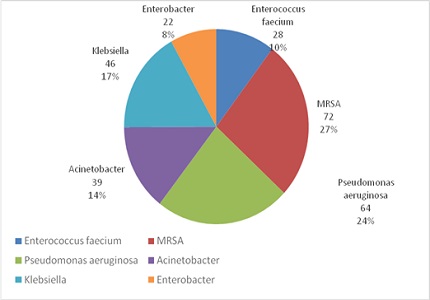A study on ESKAPE pathogens the bad bug with no drug
Abstract
Introduction: ESKAPE pathogens include Enterococcus faecium, Staphylococcus aureus, Klebsiella pnuemonia, Acienetobacter baumanii, Pseudomonas aeruginosa and Enterobacter species. Currently all these organisms are the main cause of hospital infections globally and they have the property to effectively escape the effect of antibacterial drugs. Unstoppable success of these superbugs will lead to unwinnable war. The success of these pathogens is mainly because of the mutations, modifications of LPS. As the crisis for the antibiotic resistance continues to grow, the latest IDSA (infectious disease society of America) “Bad Bugs, No Drugs” reports the urge for new antibiotics in the research and development pipeline and proposes steps to tackle the shortage.
Objective: The aim of the study was to characterize the antimicrobial resistance in ESKAPE pathogens isolated from 330 culture positive clinical sample.
Method: Antibiotic resistance was determined by VITEK 2 and manual method was done on Kirby baurer method. MIC was determined by VITEK 2 and E-Test according to CLSI guidelines.
Result: Out of the total cases 63 percent of the culture has ESKAPE pathogens. Except for S. aureus multidrug resistance index of ESKAPE pathogens revealed on increasing trend.
Conclusion: ESKAPE pathogens are commonly identified in alarming frequency and knowledge of antimicrobial resistance will be aided for empirical treatment.
Downloads
References
2. Rice LB.Federalfunding for the study of antimicrobial resistance in nosocomialpathogens: no ESKAPE.J Infect Dis. 2008 Apr 15;197(8):1079-81. doi: 10.1086/533452. [PubMed]
3. Spellberg B, Guidos R, Gilbert D, Bradley J, Boucher HW, Scheld WM, Bartlett JG, Edwards J Jr; Infectious Diseases Society of America. The epidemic of antibiotic-resistantinfections: a call to action for the medicalcommunity from the Infectious Diseases Society of America.Clin Infect Dis. 2008 Jan 15;46(2):155-64. doi: 10.1086/524891. [PubMed]
4. National Nosocomial Infections Surveillance System Report, data summary from January 1992 through June (2004) issued October 2004. Am J Infect Control 2004;32:470-85. [PubMed]
5. Lim CJ, Cheng AC, Kennon J, Spelman D, Hale D, Melican G, Sidjabat HE, Paterson DL, Kong DC, Peleg AY. Prevalence of multidrug-resistant organisms and risk factors for carriage in long-term carefacilities: a nested case-control study. J Antimicrob Chemother.2014 Jul;69(7):1972-80. doi: 10.1093/jac/dku077. Epub 2014 Apr 7. [PubMed]
6. Federico Perez, Andrea M. Hujer, Kristine M. Hujer, Brooke K. Decker, Philip N. Rather, and Robert A. Bonomo. Global Challenge of Multidrug-Resistant Acinetobacterbaumannii ANTIMICROBIAL AGENTS AND CHEMOTHERAPY, Oct. (2007), p. 3471–3484 Vol. 51, No. 10 0066-4804/07/$08.000 doi:10.1128/ AAC. 01464-06 Copyright © 2007, American Society for Microbiology.
7. Poudyal A, Howden BP, Bell JM, Gao W, Owen RJ, Turnidge JD, Nation RL, Li J.In vitropharmaco-dynamics of colistinagainstmultidrug-resistantKlebsiella pneumoniae. J Antimicrob Chemother. 2008 Dec;62(6):1311-8. doi: 10.1093/jac/dkn425. Epub2008 Oct 15.
8. Magill S. S., Edwards J. R., Bamberg W., et al. Multistate point-prevalence survey of health care-associated infections. The New England Journal of Medicine. 2014;370(13):1198–1208. doi: 10.1056/nejmoa 1306801. [PMC free article] [PubMed]
9. Klevens RM, Edwards JR, Richards CL Jr, Horan TC, Gaynes RP, Pollock DA, Cardo DM.Estimatinghealth care-associated infections and deaths in U.S. hospitals, 2002.Public Health Rep. 2007 Mar-Apr;122(2):160-6. [PubMed]
10. Giedraitienė A, Vitkauskienė A, Naginienė R, Pavilonis A. Antibiotic resistance mechanisms of clinically important bacteria. Medicina (Kaunas).2011;47(3):137-46. [PubMed]
11. Wright G. D. Bacterial resistance to antibiotics: enzymatic degradation and modification. Advanced Drug Delivery Reviews. 2005;57(10):1451–1470. doi: 10.1016/j.addr.2005.04.002. [Cross Ref]
12. Wilson DN. Ribosome-targeting antibiotics and mechanisms of bacterial resistance.Nat Rev Microbiol. 2014 Jan; 12(1):35-48. doi: 10.1038/nrmicro3155. [PubMed]
13. Rice LB. Federal funding for the study of antimicrobial resistance in nosocomial pathogens: no ESKAPE. J Infect Dis. 2008 Apr 15;197(8):1079-81. doi: 10.1086/533452. [PubMed]
14. Boucher HW, Talbot GH, Bradley JS, Edwards JE, Gilbert D, Rice LB, Scheld M, Spellberg B, Bartlett J. Bad bugs, no drugs: no ESKAPE! An update from the Infectious Diseases Society of America. Clin Infect Dis. 2009 Jan 1;48(1):1-12. doi: 10.1086/595011.
15. Rice LB.Progress and challenges in implementing the research on ESKAPEpathogens. Infect Control Hosp Epidemiol. 2010 Nov;31 Suppl1:S7-10. doi: 10.1086/655995.
16. Taubes G. The bacteria fight back. Science. 2008 Jul 18;321(5887):356-61. doi: 10.1126/science. 321. 5887.356. [PubMed]
17. Karlberg JP. Trends in disease focus of drug development. Nat Rev Drug Discov. 2008 Aug;7(8):639-40. doi: 10.1038/nrd2618.
18. Traczewski M, Brown S. PTK0796: in vitro potency and spectrum of activity compared to ten other antimicrobial compoundsProceedings of the 43rd Inter science Conference on Antimicrobial Agents and Chemotherapy (Chicago, IL), 2003 Washington, DC American Society of Microbiology.
19. Karlberg JPE.Trends in disease focus of drug development, Nat Rev Drug Discov ,2009, vol.7 (pg.639-40).
20. Glaxo Smith Kline and Mpex Pharmaceuticals form alliance to develop novel efflux pump inhibitors for use against serious gram-negative infections, 2009London, and San DiegoGlaxoSmithKline.
21. Jones RN, Guzman-Blanco M, Gales AC, et al. Susceptibility rates in Latin American nations: report from a regional resistance surveillance program. Braz J Infect Dis. 2013;17:672-81. [PubMed]



 OAI - Open Archives Initiative
OAI - Open Archives Initiative


